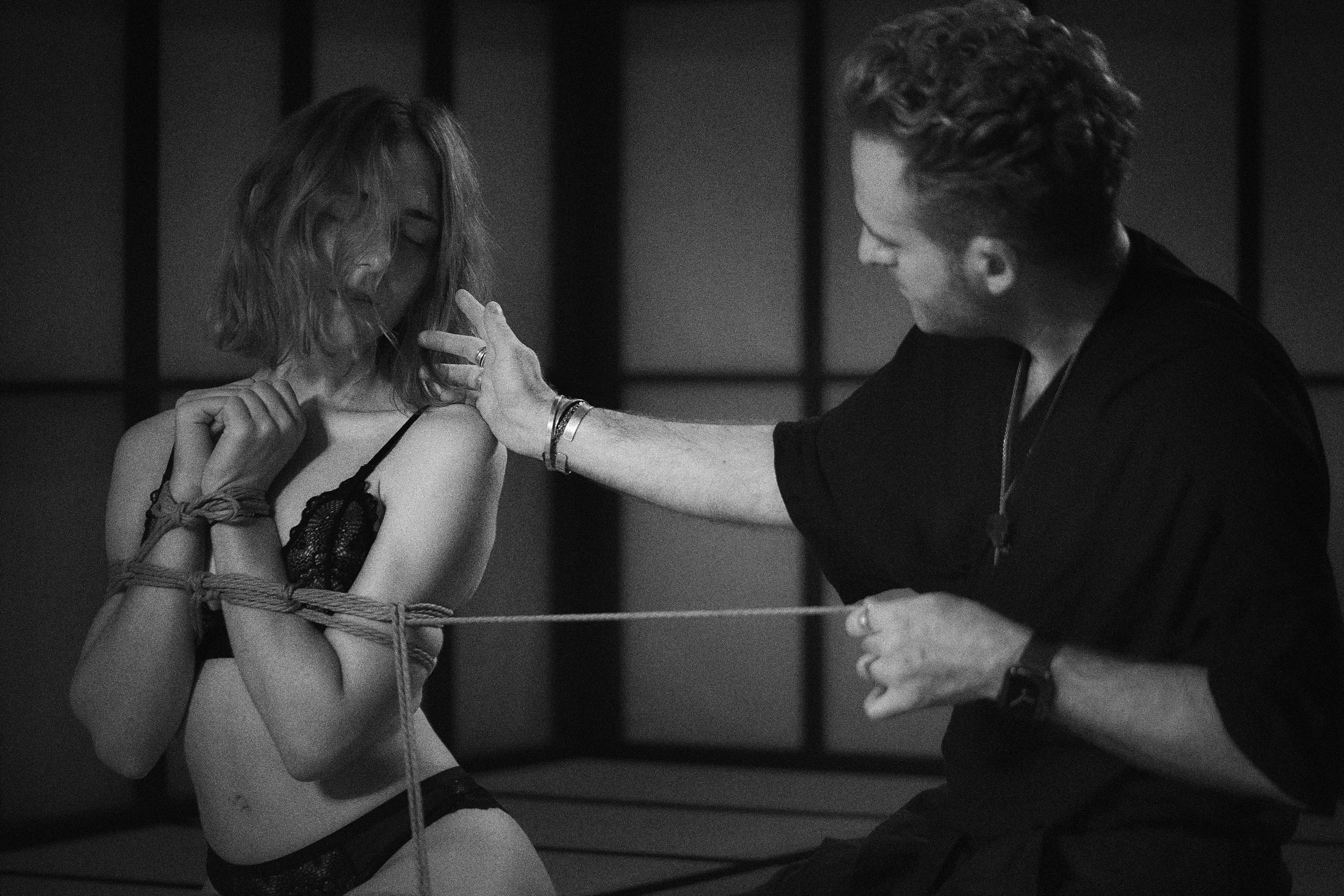The Essence of Shibari: A Physical and Emotional Journey
At its core, Shibari is not just a technique of tying knots — it’s a dialogue between two people, communicated through tension, touch, rhythm, and breath. The experience works on two intertwining levels:
the physical, where the body reacts to touch, pressure, restriction, and release;
and the emotional, where feelings of surrender, trust, vulnerability, and connection emerge.
Physical Dimensions
Body Awareness: The sensation of ropes wrapped with tension around your body heightens your awareness of muscles, skin and certain body parts. The restriction of your breath makes you aware of your breathing. For example, you can feel how your chest presses against the ropes, leading you to breathe deeper and slower. People often feel more “in” their body and very grounded.
Deep Sensory Feedback and Tactile Stimulation: The gentle, sustained compression from the ropes stimulates deep pressure receptors, which tells your brain: I am safe, I am being held. It’s similar to the calming effect people experience from weighted blankets or firm hugs — again, a grounding and secure feeling.
This deep pressure stimulation is believed to activate the parasympathetic nervous system, which is responsible for the body's relaxation response. This can help reduce anxiety, stress, and feelings of being overwhelmed.
The pressure can trigger the release of endorphins, natural mood boosters that contribute to feelings of well-being and relaxation.
Additionally, the feeling of the natural fibres pressing or sliding against the skin can be calming or also arousing, depending on your intention.Balancing Tension and Release: Shibari plays with a rhythm between tension and relaxation — sometimes the body is under more stretch or restriction, then released again. This ebb and flow helps regulate the nervous system, teaching it to expand into sensation and then relax again, in a safe environment. It's basically a practice of letting go and surrender into a certain situation.
Flow States: During longer sessions, many people enter a flow-like trance state, where mental overthinking shuts down and sensory awareness heightens. This slowing down of constant thinking and analysing is leading you to a sense of timelessness, presence, and deep embodiment.
Rope High & Rope Drop: After a session, people often report feeling warm, peaceful, and emotionally open. This is called the “Rope High” or in general being in a “Rope Space”, similar to the term “Sub Space” in BDSM.
Again, through the release of endorphins and oxytocin, your brain might create a sense of high feeling also being more calm, connected, and sometimes even bliss. It’s also common to feel emotionally lighter or clearer after an intense Shibari session.
On the other hand, this intense release of hormones into your body can lead to a so-called “Rope Drop”, you could compare it with a kind-of hang over. Therefore, if you tie with someone you are not so close with, it's good to check in on each other the next day and see how they feel.
Emotional Dimension
Domination, Trust and Surrender: In Shibari we play with polarities of domination and surrender, which means the active person creates a safe structure where the passive person is invited to surrender, this is usually very rare in our modern life. For many, this is deeply freeing and maybe even healing on a certain level. Making the positive experience of being held by someone and able to trust and let go of control.
Vulnerability: When you’re in ropes, you surrender a degree of movement and control. Your body is exposed, you're not performing — you're simply being.
This level of stillness and exposure often brings your awareness deeply inwards, you might ask yourself: How do I feel in this body?
Can I allow myself to be supported?
What happens when I stop controlling everything?
This can bring up a profound sense of presence and embodiment, because you’re no longer "doing" — you're being held.
You might feel seen without needing to explain yourself. Or you might cry without knowing why. Furthermore, you might laugh, tremble, or drop into total stillness.
And while this vulnerability can feel intimidating, in a safe and respectful setting, it often becomes one of the most transformative aspects of the practice.This doesn’t mean that every session is intense or dramatic. Sometimes it’s very quiet, or even playful. But the possibility of a real emotional experience is always there. That’s vulnerability in Shibari — not weakness, but courageous openness.Connection and Presence: Shibari fosters a non-verbal, mindful connection between the tying partners. There’s a shared rhythm and flow where both are fully present. The active partner is leading, but also listening deeply to the reactions of the passive partner. They reach a high state of connection with themselves, the present moment and each other.
Inner Journey: Many people experience Shibari like a deep meditation or even therapy, but I’m not a fan of this wording in relation to Shibari, I’m not a trained therapist, and I’m only tying with people who come with a healthy mind and body.
However, old emotions can surface, deep relaxation can happen, or people simply feel seen and held.
In Summary
Shibari offers a unique combination of holding and freedom, constraint and release, tension and stillness. It’s an art form that bypasses words and takes people into their felt senses — for some it’s sensual, for others meditation, an intense full body massage, or even a play with pain and BDSM elements.

